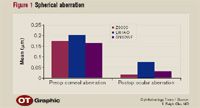Article
Aspheric monofocal lenses offer improved visual acuity
San Francisco-Three aspheric IOLs-Tecnis Z9000 (Advanced Medical Optics [AMO]), AcrySof SN60WF (LI61AO, Alcon Laboratories), and SofPort AO (Bausch & Lomb)-were compared in two separate trials by two different groups of investigators.

The first compared the effects of the three IOLs with those of two spherical IOLs, AR40e (AMO) and AcrySof SN60AT (Alcon) and found that all three achieve improved visual acuity following cataract surgery. The retinal image contrast and visual performance also improved in this trial conducted by Francesca Lepri, MD, and associates.

Dr. Lepri reported her group's experience with the aspheric IOLs, which have a modified prolate anterior surface and increasing total spherical aberrations by increasing the pupil size. She is affiliated with the Department of Science, Ophthalmology, and Neurosurgery, University of Siena, Siena, Italy.
This prospective study comprised 150 patients who underwent phacoemulsification and were randomly assigned to receive one of the five types of foldable IOLs. Visual acuity was measured preoperatively and 1 day, 1 week, and 1, 3, and 6 months postoperatively using the Early Treatment Diabetic Retinopathy Study chart. Fundus photography and photopic and mesopic functional acuity contrast testing were performed preoperatively and 6 months postoperatively. Contrast sensitivity was measured by sinusoidal grating charts for distance at photopic and mesopic luminance levels. Data regarding subjective glare, pupil size, and wavefront aberration of the cornea and eye were collected 1 and 6 months postoperatively.
"The visual acuity results under photopic conditions showed no statistically significant difference between the patients who received the aspheric IOLs and those who received the spherical IOLs," she said.
The investigators studied contrast sensitivity under photopic and mesopic conditions using different spatial frequencies at 3, 6, 12, and 18 cycles per degree.
"There were no significant differences in the patients with aspheric IOLs under photopic and mesopic conditions, even though there was a significant difference between the aspheric and spherical IOLs," she said.
The corneal spherical aberrations were studied at the third month after implantation to determine if surgery induced any changes. However, as they expected, the investigators found no significant difference in corneal spherical aberrations over time with a 5-mm pupil.
When they studied the corneal aberrations using the Zywave Aberrometer (Bausch & Lomb) in 5-mm pupils, there was no significant difference among the aspheric IOLs in increased aspherical aberration, but there was a very significant difference between the aspheric and spherical IOLs.
Visual functioning
Dr. Chu, medical director of Chu Vision Institute, Edina, MN, and colleagues compared the early results they achieved during a comparison study of the three aspheric IOLs.
"We know that functional visual acuity is not completely described by Snellen acuity, contrast sensitivity is important for functional safety, and contrast sensitivity decreases with aging as the spherical aberration increases inside the eye," Dr. Chu said.
Newsletter
Don’t miss out—get Ophthalmology Times updates on the latest clinical advancements and expert interviews, straight to your inbox.




